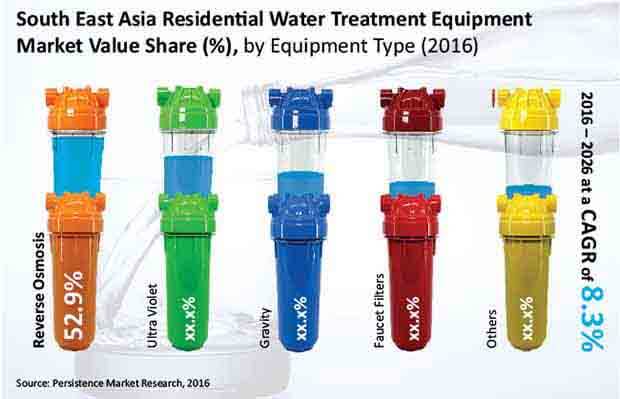Residential Water Treatment Equipment Market Segmented By Purification Equipment, Reverse Osmosis, UV, Gravity/Media, Filtration Equipment, Faucet Filters Equipment Type
Industry: Consumer Goods
Published Date: February-2017
Format: PPT*, PDF, EXCEL
Delivery Timelines: Contact Sales
Number of Pages: 119
Report ID: PMRREP13675
In terms of value, the UV water purifier equipment segment is estimated to account for more than 20% of overall market. However, in terms of volume, the segment is estimated to hold below 10% of the overall water treatment equipment market volume. The segment is expected to create incremental opportunity of more than US$ 100 Mn over the forecast period.
Most of the UV based water purifier equipment segment revenue is expected to be generated from Vietnam and Malaysia. The UV water purifier equipment segment was valued at more than US$ 50 Mn in 2014 and is anticipated to reach a market value of more than US$ 100 Mn by 2026 end. In terms of value, the segment is expected to increase 2.4X between 2016 and 2026.
Due to large scale industrialization and rampant use of pesticides, the quality of naturally available water in South East Asia is deteriorating. Various water bodies that provide water for drinking to many thousands of local inhabitants are showing unacceptable levels of potentially toxic substances.
These pollutants originate from a variety of sources, including local industries and wastewater disposal. Deteriorating water conditions in the region and lack of confidence on municipality supplied water or absence of the same is creating the need for purification of water, further fueling the demand for UV water purifiers.
An increasing population of South East Asia coupled with the government’s inability to provide safe drinking water at the same scale is driving the need for residential water treatment. This factor is creating robust development in the UV water purifier segment. The rising availability of low cost gravity/non electric purifiers based on UF membranes has significantly altered the scenario in the water purification equipment market. With advancement in technology, the cost of gravity water purifiers is expected to further reduce, hence fueling the demand for water purifiers with UV technology.

The UV water purifier segment in Indonesia was valued at more than US$ 32 Mn in 2015 and is projected to be valued at more than US$ 90 Mn by 2026. Revenue generated from this market is expected to increase at a CAGR of 9.9% over the forecast period. In terms of volume, unit sales of UV purifiers in Indonesia stood at more than 200 thousand units and is projected to reach more than 500 thousand units by 2026. Demand for standalone UV water purifiers has witnessed sluggish growth over the last five years.
This is mainly attributed to its inefficiency to purify metallic contaminants. As a result, companies are offering UV based water purifiers in conjugation with RO and gravity based water purifiers. The UV water purifier segment in Malaysia was valued at more than US$ 5 Mn in 2015 and is projected to be valued at more than US$ 10 Mn by 2026. Revenue generated from this market is expected to increase at a CAGR of 6.7% over the forecast period. Sales of standalone UV water purifiers in the country seemed pessimistic over the past 2 years.
Sales of these equipment dropped by 1.5% between 2013 and 2015. This is mainly attributed to increased preference for gravity water purifiers over UV based water purifiers. For instance, Philips witnessed slowdown in sales of UV water purifiers during the same period in the country.
The UV water purifier segment is expected to create incremental opportunity of more than US$ 5 Mn in Malaysia between 2016 and 2026. In order to generate high ROI, companies need to run promotional campaigns to promote UV based water purifiers in the country.
|
By Equipment Type |
|
|
By Countries |
|
To know more about delivery timeline for this report Contact Sales
